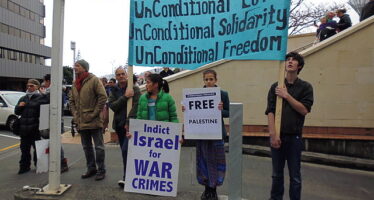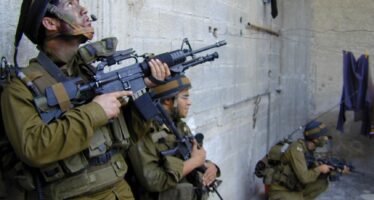The Story of Gaza
![]()
Aoung authors of fiction from Gaza, some of whom say they are finding Palestine on the internet while unable to see it exist in reality, have just published a collection of stories, written in English, marking the five-year anniversary of the 23 days from December 27, 2008, until Obama’s inauguration, during which Israel bombed the people of Gaza far more heavily than usual. They’re publishing a new excerpt of the book each of these 23 days on their FaceBook page. You can talk with them in an upcoming Google Hangout.
For five years, the world — just like Obama — has overwhelmingly been “looking forward” when it comes to crimes committed by nations aligned with the U.S. government. But the crimes in Gaza then and now, and in other countries, have been exposed to unprecedented “looking present” through immediate real-time blogging available to those actively looking, even in the places responsible for the far-away terrorism-too-big-to-call-by-
The telling of truer-than-news stories by these young Gazans has the potential to reach many more minds, and to set an example that just might scare off the next “humanitarian war” no matter where it’s targeted. If victims of military benevolence can have their stories read by people who matter, or who could matter if they acted, and if those stories inevitably effect understanding of the obvious-but-always-denied fact that they are like we, that those people are people just like these people, that something has “brought out their humanity,” then the shock and awe might have to move from its fictional location in the streets of non-humans’ cities to a real existence in the offices of Lockheed Martin.
The stories in this book are of childhood and family, love and loss, soccer and toothaches. As with any story, people are placed in particularly special circumstances. A visit to the doctor is a visit to someone making decisions of triage: Will your father be sent to a specialist to be saved, or will this baby who has a better chance at living be sent instead? Two farmers, a Gazan and an Israeli unknowingly stand just inches or feet away from each other, separated by an impenetrable wall. A Gazan and an Israeli are perhaps attracted to each other, but blocked by a wall that needs no physical presence. A child is listening to a bedtime story when a missile strikes the house. Who will live? And who will be traumatized? Or was everyone pre-traumatized already?
“I spent that night thinking of Thaer’s home, of the distant life in Mama’s eyes. I kept wondering what’s more torturous: the awful buzz of the drone outside or the sounds of some tough questions inside. I guess I eventually slept with no answer, thanking the drone for not giving my inner uproar any chance to abate.”
Children in Gaza know the names of books, of toys, of movies, of trees, and of deadly flying aircraft. Some of the latter are called “Apaches,” named after a people marched, and imprisoned, and slaughtered by the U.S. military, people kept in camps that inspired the Nazis’, whose camps in turn inspired what the nation of Israel now does to non-Jewish African immigrants. How long will it be before little children in China are pointing to the sky in fear of a swarm of “Gazas”?
These stories are of people and of land, and of efforts to understand other people on the land. Understanding is a challenge:
“If a Palestinian bulldozer were ever invented (Haha, I know!) and I were given the chance to be in an orchard, in Haifa for instance, I would never uproot a tree an Israeli planted. No Palestinian would. To Palestinians, the tree is sacred, and so is the Land bearing it.”
Gazans try to imagine what goes on in the minds of Israeli soldiers, particularly those soldiers who have killed their family members. One story tells the tale of an Israeli soldier’s regret (or what we like to clinically and cleanly call PTSD), and of the soldier’s wife’s efforts to ease his pain:
“Honey, you were doing your job to follow orders. It’s alright.”
These words come as kind words of comfort, spoken to a man beyond the point of being able to hear them. And at the same time they come as an articulation of an ongoing horror of immense proportions. The contrast of these multiple meanings might make us all stop and question what we hear too often without thinking. Here in the United States, for example, any soldier in uniform gets on any airplane first and is thanked for his or her “service.” Surely not thanking someone for their service would be impolite. But those who flip the switch on our prisons’ electric chairs aren’t thanked. Those who risk their lives to put out fires are not thanked. Only those who kill in war, even as their largest current killing operation — in Afghanistan — has the support of 17% in the U.S. and polling around the globe finds a consensus that the United States is the leading threat to peace on earth.
The stories from Gaza are not essays. They do not address the inevitable “What about the Gazans’ own violence?” One need not misunderstand the nature of the occupation, the slow genocide, the international injustice, the vastly disproportionate violence and suffering imposed on one side of this so-called conflict in order to believe that “What about the Gazans’ own violence?” is a reasonable question. Nor need one be a Gazan or an inexcusably arrogant and unsympathetic fool to have the right to disagree with the usual answer. The stories come with an introduction from the editor in which he expresses support for this well-known concept: “by any means necessary.” I prefer this phrasing: “by any means effective.” Means that most easily express rage are sometimes misinterpreted as necessary, while means that have the best chance of succeeding are rejected for not having a greater chance than they do.
The stories themselves don’t actually take up that debate. Rather they depict the struggle merely to survive, the bravery that we may in fact all need everywhere if the earth’s climate goes the way scientists expect. These young people from Gaza may become leaders in a movement to create peace and justice before madness and disaster-imperialism overtake the comfortable and the forgotten alike. I wonder if, and hope, they know the Afghan Peace Volunteers, and the people of No Dal Molin in Italy, and of Gangjeong Village on Jeju Island, and I hope they will join a new worldwide movement to end war that will be launching next year.
David Swanson is author of War is a Lie. He lives in Virginia.
Related Articles
Gaza / Israel: la ordenanza de la Corte Internacional de Justicia
![]()
Este 26 de enero del 2024, la Corte Internacional de Justicia (CIJ) dio a conocer su ordenanza, repondiendo a la solicitud urgente de medidas provisionales interpuesta por Sudáfrica contra Israel el pasado 29 de diciembre del 2023
Israel demolishes security barrier at Gilo
![]()
Israel demolishes security barrier at Gilo Military officials said it was the first time they had to take down such
Somehow the Flowers were Silent
![]()
Shireen Abu Akleh, correspondent for Al Jazeera Arabic, assassinated on May 11, 2022, Jenin Camp, in the Occupied West Bank





